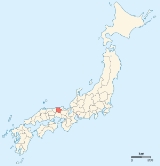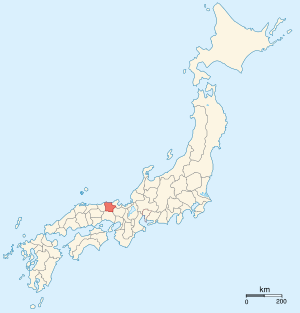
Tajima Province
Encyclopedia

Hyogo Prefecture
is a prefecture of Japan located in the Kansai region on Honshū island. The capital is Kobe.The prefecture's name was previously alternately spelled as Hiogo.- History :...
. It was sometimes called . Tajima bordered on Harima
Harima Province
or Banshu was a province of Japan in the part of Honshū that is the southwestern part of present-day Hyōgo Prefecture. Harima bordered on Tajima, Tamba, Settsu, Bizen, and Mimasaka Provinces. Its capital was Himeji....
, Inaba
Inaba Province
was an old province of Japan in the area that is today the eastern part of Tottori Prefecture. It was sometimes called . Inaba bordered on Harima, Hōki, Mimasaka, and Tajima Provinces.-History:The ancient capital, and the castle town, were at Tottori city...
, Tamba
Tamba Province
was an old province of Japan. The ambit of its borders encompassed both the central part of modern Kyoto Prefecture and the east-central part of Hyōgo Prefecture. It was sometimes called , with Tango Province...
, and Tango
Tango Province
was an old province in the area that is today northern Kyoto Prefecture facing the Sea of Japan. It was sometimes called , with Tamba Province. Tango bordered on Tajima, Tamba, and Wakasa provinces....
provinces.
Tajima is most notably known for its being the birthplace of Kobe beef
Kobe beef
refers to cuts of beef from the black Tajima-ushi breed of Wagyū cattle, raised according to strict tradition in Hyōgo Prefecture, Japan. The meat is generally considered to be a delicacy, renowned for its flavour, tenderness, and fatty, well-marbled texture. Kobe beef can be prepared as steak,...
, known locally as Tajima Beef
Tajima cattle
is one of the types of black Wagyū cattle in Japan. Many tajima cattle are born in Hyōgo Prefecture and raised as stock for famous beef such as Kobe beef and Matsuzaka beef.Tajima cattle has been fed from old times in Tajima Province...
. Also well known are its many onsen
Onsen
An is a term for hot springs in the Japanese language, though the term is often used to describe the bathing facilities and inns around the hot springs. As a volcanically active country, Japan has thousands of onsen scattered along its length and breadth...
s, beaches, and small ski resorts. Its main industries are forestry, fishing, farming, and tourism.
History
The ancient provincial capital is near the modern town of HidakaHidaka, Hyogo
was a town located in Kinosaki District, Hyōgo, Japan.On April 1, 2005 Hidaka, along with the towns of Kinosaki and Takeno, all from Kinosaki District, and the towns of Izushi and Tantō, both from Izushi District, was merged into the expanded city of Toyooka and no longer exists as an independent...
.
A major castle town was built at Izushi
Izushi, Hyogo
was a town located in the former Izushi District, Hyōgo, Japan.On April 1, 2005 Izushi, along with the towns of Kinosaki, Hidaka and Takeno, all from Kinosaki District, and the town of Tantō, also from Izushi District, was merged into the expanded city of Toyooka and no longer exists as an...
. Izushi jinja
Izushi jinja
is a Shinto shrine located in the west of Toyooka in Hyōgo Prefecture in Japan.-History:Historical records present conflicting narratives about the foundation of the shrine in the 1st century BC. It was mentioned in the Kojiki and the Nihonshoki....
was designated as the chief Shinto Shrine (ichinomiya) for the former Tajima province
Tajima Province
was an old province of Japan in the area that is today northern Hyōgo Prefecture. It was sometimes called . Tajima bordered on Harima, Inaba, Tamba, and Tango provinces....
.
For much of the Sengoku Period
Sengoku period
The or Warring States period in Japanese history was a time of social upheaval, political intrigue, and nearly constant military conflict that lasted roughly from the middle of the 15th century to the beginning of the 17th century. The name "Sengoku" was adopted by Japanese historians in reference...
this area was ruled by the Yamana clan
Yamana clan
The ' was a Japanese samurai clan which was one of the most powerful of the Muromachi period ; at its peak, members of the family held the position of Constable over eleven provinces. Originally from Kōzuke province, and later centered in Inaba province, the clan claimed descendance from the Seiwa...
, who submitted to Oda Nobunaga
Oda Nobunaga
was the initiator of the unification of Japan under the shogunate in the late 16th century, which ruled Japan until the Meiji Restoration in 1868. He was also a major daimyo during the Sengoku period of Japanese history. His opus was continued, completed and finalized by his successors Toyotomi...
.

